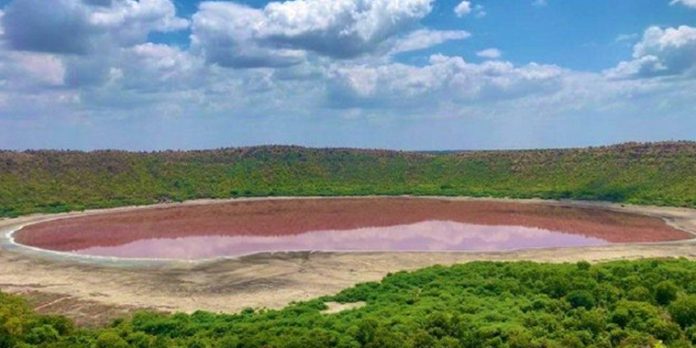Aurangabad: Situated around 500 kms from the state’s capital Mumbai, the Lonar Lake’s colour has changed to pink overnight. The lake was formed after a meteorite hit the Earth about 50,000 years ago.
According to experts, the surprising incident has occurred due to the saline content and presence of algae in the lake which has a mean diameter of 1.2kms.
The water body is located in the Budhana district of Maharashtra and is a popular tourist spot with the scientists from over the world too showing immense interest in its vivid characters. The recent change of color in the lake has attracted the attention many nature enthusiasts and analysts.
It has been claimed by experts that it is not the first time the lake has changed to a different color, but this time it is more evident.
Member of the Lonar lake conservation and development committee, Gajanan Kharatlake, has said that the lake, which is a notified national geo-heritage monument, has saline water with a pH of 10.5.
“There are algae in the water body. The salinity and algae can be responsible for this change,” he said.
“There is no oxygen below one meter of the lake’s water surface. There is an example of a lake in Iran, where water becomes reddish due to an increase in salinity,” he noted.
Gajanan Kharat said the level of water in the Lonar Lake at present is lower than the levels recorded in the past years due to the absence of rain which was a source of filling the lake with fresh water.
“The low level of water may lead to increased salinity and change in the behaviour of algae because of atmospheric changes…this may be the reason for colour change. This is not the first time that the colour of water has changed,” he said.
Dr Madan Suryavanshi, head of the geography department of Aurangabad’s Dr Babasaheb Ambedkar Marathwada University, said looking at the scale of this colour change, “this can’t be a human intervention”.
“In case of a natural phenomenon, there are fungi which generally give a greenish colour to water most of the times. This (the current colour change) seems to be a biological change in the Lonar crater,” he said.
“During the lockdown phase, there may not have been any disturbance to water which led to this change,” he said.
“Season-wise changes occur in water and this might be the case with the Lonar lake. We can examine the change if we go there in a week…then we can say more about the change,” he said.


